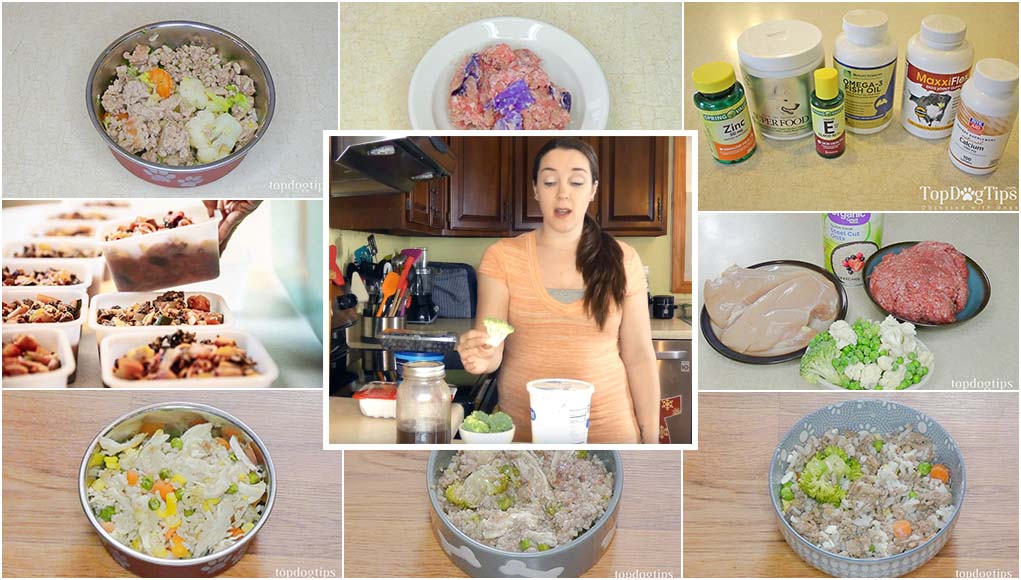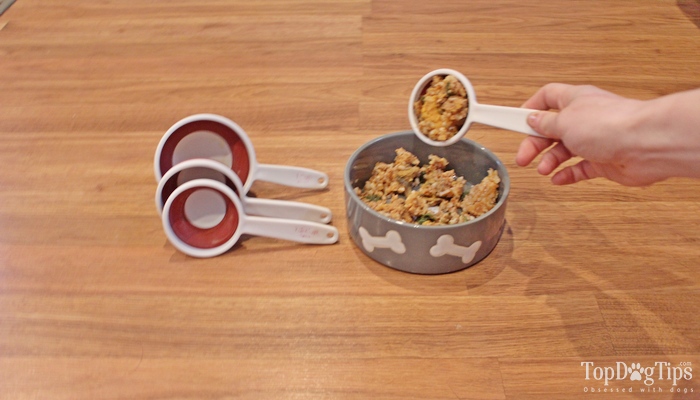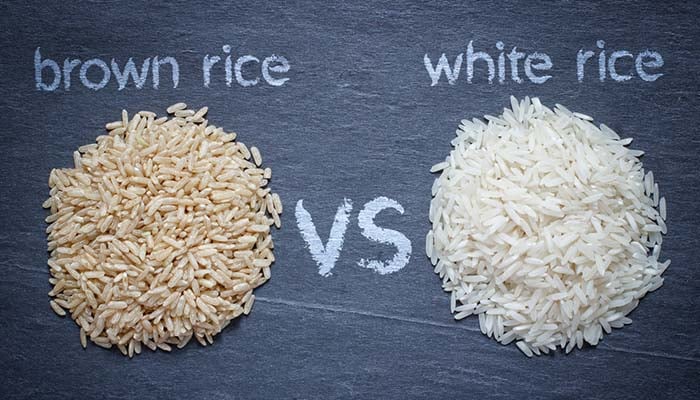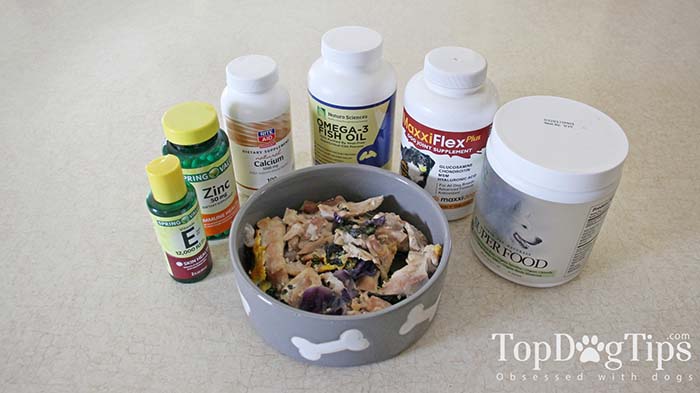Having published over a hundred different homemade dog food recipes, I'm starting to receive an increasing amount of emails with questions about cooking for dogs. Many of these questions are same or very similar, so I decided to address the most common ones in this single article.
I plan to keep updating this article, so if you have a question that hasn't been address yet – ask away in the comments below, and I'll have it added and answered in this article.
1. “How Often and How Much Homemade Dog Food Should I Feed My Dog?“
The answer to this question depends on many factors, like your dog’s weight, age, health and lifestyle. When I publish a recipe, I cannot personally determine the exact amount of food your individual dog should eat on a daily basis and the best thing for you to do is to consult your veterinarian because he can take all of the necessary factors into account.
That being said, there's a rule of thumb of sorts: for most homemade dog food recipes, I recommend feeding about 1/2-3/4 of a cup of food for every 25 pounds of dog's body weight. I've talked about this more in-depth in my video/article here, which I strongly recommend you check out.
When it comes to the frequency of feeding, adult dogs are usually fine with just one or two meals a day. However, smaller breeds and dogs with sensitive stomachs should be fed more often in smaller amounts. Puppies should eat as much as they want, 4-5 times a day for the first six months. After that, you can feed your pup 2-3 times a day.
2. “Can I Substitute Protein Sources?“
Yes, you can always substitute a protein source I use in my homemade dog food recipes with something else, as long as it's also meat and dog-friendly. This is most commonly done either for financial reasons or if your dog is allergic. So, if I'm using beef, you can exchange it for chicken, for example.
Most common protein sources in home diets include beef, chicken and turkey, but some canines may be allergic or sensitive to these ingredients. Other substitutions you can use instead are: rabbit, lamb, venison, bison, goat. I've talk more about substitutions in homemade dog food recipes in my video/article right here.
3. “Can I Substitute Carbohydrates?“
Yes, you can. It's the exact same situation as with protein substitutions I've mentioned above, though bear in mind that carbohydrates are far more varied than animal meat protein sources, so you need to be more careful about what you're using in the recipe.
I recommend you read the above linked article, but the most common carb sources I use in my recipes come from the category of grains known as “cereal grains.” Carbohydrates that you can generally use to substitute sources in my recipes are: brown rice, whole wheat, oats, barley, corn, white potato, sweet potato.
The same goes for fruits and vegetables. As long as they're dog-friendly and non toxic, you can use your source of vegetable or fruit instead of my recommended. Just remember that they all come with different nutritional content, and your goal with homemade recipes is to ensure that the food is well-balanced.
Always take note of what nutrition you're including so that you don't miss any essential nutrients. Fruits and veggies I generally use are: apples, bell peppers, bananas, broccoli, blueberries, carrots, cantaloupes, green beans, mangoes, peas, zucchini.
4. “Is Brown Rice Better for Dogs Than White Rice?“
There is no right answer to this question. Both brown and white rice are perfectly fine for dogs to eat, and they come with different benefits. Rice (white or brown) is not among the most common ingredients I use in my recipes, but I do use it now and again.
White rice is easier for dogs to digest and chew, and it is usually less expensive than brown rice. On the other hand, brown rice is sightly richer in protein and starch and has a much higher nutritional value in general because it is not as processed as white rice. However, brown rice is also rich in fiber, which can upset your dog’s stomach if he eats too much of it (but can be helpful for dogs who may need extra fiber in the diet).
The bottom line is that either one is fine. Choose the type of rice depending on the situation. White rice is great for stomach problems, especially upset stomach, and diarrhea. Brown rice is good for constipation and for weight gain due to its high protein content. Whatever type of rice you choose, just make sure to cook it properly.
5. “Will Homemade Dog Food Be Nutritionally Balanced for My Dog?“
Homemade dog food can absolutely be nutritionally balanced, but it's generally hard to achieve that without doing plenty of research and delving deep into the details of each ingredient you include. It is up to you to make a plan for a nutritionally balanced diet and stick to it.
For the most well-balanced meals, there's a type of “homemade dog food calculator” you can use to better figure out how much to feed and how to make those meals appropriate for your pooch. There's too much to explain in this short article, so for more details, I recommend you see my dog food calculator video/article and how to use it.
The problem with homemade dog food not being nutritionally balanced usually comes from the fact that dog owners don’t know what a nutritionally balanced diet entails or that they don’t follow instructions provided by their vet or nutritionist. I address this and other crucial aspects of cooking for dogs in my article/video here.
It's likely going to be more time-consuming and difficult in the beginning, but once you get used to cooking for your dog, familiarize with most ingredients and know what your pup likes, you'll find a way to make well-balanced food. If you're just starting, I recommend consult with a vet and/or canine nutritionist to come up with a plan.
6. “What Supplements Should I Add to Make Homemade Meals Nutritionally Balanced?“
Before I can answer this question, we must first take a look at what a nutritionally balanced doggy meal looks like:
Protein – found in animal meat, seafood, dairy and eggs. At least 25-35% of your dog’s meal should include high-quality proteins, but many recommend more. You can add more proteins to your dog’s diet and decrease carbs but make sure to use lean protein sources to avoid adding extra fats to your dog’s meal. Whether you do homemade or raw diet, or a mix of both, organ meats can also be very good.
Carbohydrates – found in beans, cereal grains, and fruits and vegetables. Anything from 30-50% of your dog’s meal can come from carbs.
Fats – found in fatty meats, fatty fish and oils. Keep the fats intake in the 10-20% range. Fats are healthy for your dog, and can be a source of energy. Essential fatty acids such as omega-3s from fish are a necessary part of a balanced diet.
Minerals and Vitamins – found in fruits, vegetables, grains and meat (especially organ meat). Dogs need a certain minerals and vitamins more than others, especially calcium and phosphorus in specific stages of their lives, and they need to have less of these during other stages of their lives. Research is essential here.
It's very common to use supplements in a homemade diet. I've talked more about this in my video/article here. The most common supplement a dog might need even if you feed him a nutritionally balanced diet is calcium because dogs need a lot of it (around 50 mg per 2lbs of body weight) and that is hard to provide with a home diet unless you feed your dog raw bones, or mix it up with kibble.
Other important minerals and vitamins your dog needs include phosphorus, sodium, magnesium, potassium, sulfur, chloride and vitamins A and E. If you don’t provide the daily requirements of vitamins and minerals in your dog’s homemade meals, you need to use supplements to avoid vitamin deficiency.
It can be hard to make a plan for nutritionally balanced homemade diet by yourself, so once again, I recommend you consult your vet or nutritionist about supplements you should use – this is usually the safest course of action when you're starting out.
7. “Can I Use Supplements Instead of Protein Sources?“
This is not recommended. Technically, you can use them in small amounts to substitute a bit of natural protein sources, although that is not really necessary and may even be harmful. Even if your dog is allergic or sensitive, there are many different protein sources you can use for homemade dog food that your pup should be fine with: chicken, turkey, beef, lamb, rabbit, fish, cottage cheese and eggs; and they will be cheaper than protein supplements.
If you want to use protein/muscle supplements in your dog’s food, avoid whey protein because it is derived from wheat and milk sources which are not really suited for a dog's digestive system and can sometimes lead to health problems.
8. “Can I Use Supplements Instead of Fruits/Vegetables?“
Yes, technically you can supplement many important nutrients regularly found in fruits and vegetables. However, there are still a lack of studies on how well dogs absorb some supplements and generally, using fresh fruits and vegetables in your dog’s homemade food is much better. It will also make it tastier and you can always give your dog raw fruits and vegetables as snacks to ensure proper intake of minerals and vitamins.
9. “How Do I Figure out How Many Calories a Recipe Has?“
The only way to do this is to calculate the calories based on each ingredient and its amount used in the dog food recipe. This can be hard to do at first because you would have to find sources for calorie content for every ingredient and then add them all up, but after a while doing this, you simply begin to know all the numbers and don't need to do that research anymore. You can also use this calorie calculator to speed up this process.
10. “How to Figure Out Guaranteed Analysis of Meals?“
The guaranteed analysis (percentage of protein, fat, carbs, fiber and phosphorus) is the information about the exact nutrition commercial dog foods provide, and all dog food manufacturers by law are required to provide guaranteed analysis on their products. This is usually calculated through computer software or lab analysis.
This means that it’s really hard to do this by yourself. The best way to guesstimate guaranteed analysis of your homemade meals is by doing a lot of math and consulting a canine nutritionist who's likely more well-versed in this. You can also find pre-calculated guaranteed analysis for some homemade recipes on this website.
11. “How Do I Transition My Dog to Homemade Dog Food?“
You should do it slowly and carefully, preferably in consultation with your vet or dog nutritionist. Anytime you make changes to your dog’s diet, whether it's switching to home meals, raw diet or even a new type of kibble, you have to do it gradually over 1-2 weeks. I would also recommend starting with some less complicated recipes – check out my 15 personal favorite ones.
Switching from commercial dog foods to homemade recipes can have serious effects on your dog’s health if you are not careful. Educate yourself first about nutritionally balanced diet to make this transition as safe as possible by first making an occasional homemade meal, and increasing the frequency over a few weeks until you're completely switched over (or, you can keep feeding your pup both kibble and home meals).
It is best to start off with the same portions as you are currently feeding your dog if you are planning to switch to homemade food. You need to keep observing your dog, his appetite, his stools and weight. After awhile, you can determine whether you need to increase or decrease the amount based on the weight changes, or if any changes are needed based on your pup's reactions to food.
12. “How Do I Store Homemade Dog Food Meals?“
Storing home meals is almost as easy as storing commercial foods. You can store your homemade meals in your refrigerator for up to three days without any safety concerns. Some foods and especially treats you can be refrigerated for longer, but that all depends on the ingredients. I always recommend storing them in air seal containers. You can also freeze the homemade dog food you made and defrost it as needed.
13. Anything Else?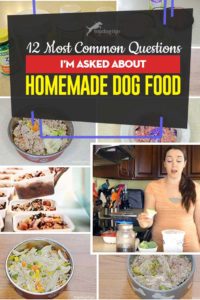
The above questions are some of the most common I receive daily, and I tried to answer them in as much detail as the length of this article allows. I would recommend following the included links to read my other articles on the related subjects.
In the meantime, have I missed anything? Do you have any questions that haven't been addressed and you think they should be? Let me know in the comments below, and I'll include them here upon my next update.
READ NEXT: 50 Best Homemade Dog Food Recipes


